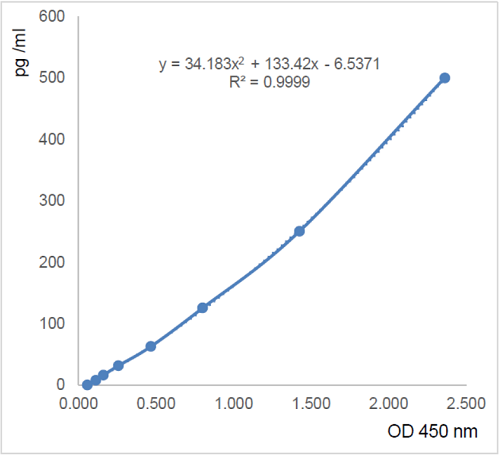
IL-36alpha (human) ELISA Kit

AG-45B-0013
Overview
- SupplierAdipoGen Life Sciences
- Product NameIL-36alpha (human) ELISA Kit
- Delivery Days Customer10
- ApplicationsELISA
- Assay Detection Range7.8 to 500pg/ml
- Assay Sensitivity4pg/ml
- Assay SpecificityDetects natural and recombinant human IL-36alpha (IL-1F6).
- CertificationResearch Use Only
- Scientific DescriptionELISA Assay. Detects natural and recombinant human IL-36alpha (IL-1F6). Colorimetric sandwich assay. Sample types: Cell Culture Supernatant, Plasma, Serum. Range: 7.8 to 500pg/ml. Sensitivity: 4pg/ml. IL-36alpha (IL-1F6), IL-36beta (IL-1F8) and IL-36gamma (IL-1F9) are members of the IL-1 cytokine family that bind to IL-36R (IL-1Rrp2) and IL-1RAcP, activating similar intracellular signals as IL-1 and are inhibited by IL-36Ra. IL-36alpha, beta and gamma cytokines, similarly to IL-1beta, need to be processed to acquire their full agonist or antagonist activity. Neutrophils proteases have been identified as the chief regulators of the processing of all the IL-36 family members, although with different specificity and affinity. IL-36alpha seems to be activated by both neutrophil Elastase and cathepsin-G, however, with differential patterns. The expression of IL-36 cytokines occurs mainly in the lung and skin and can be derived from diverse epithelial cell types including keratinocytes, bronchial epithelium as well as macrophages, monocytes and different T cell subsets. IL-36 family members induce the production of pro-inflammatory cytokines, including IL-12, IL-1beta, IL-6, TNF-alpha and IL-23, thus promoting neutrophil influx, dendritic cell (DC) activation, polarization of T helper type 1 (Th1) and IL-17-producing T cells (alphabeta T cells and gammadelta T cells) and keratinocyte proliferation. The IL-36 cytokines may represent potential targets for immune-mediated inflammatory conditions or, alternatively, could be used as adjuvants in vaccination. IL-36alpha and IL-36beta augmented IL-17A-mediated induction of antibacterial peptides in psoriasis. A significant increase in circulating and tissue levels of IL-36alpha occurs in Sjoegrens syndrome patients. An increased expression of IL-36 alpha and IL-36 gamma, but not IL-36 beta has been observed in colonic inflammatory lesions from patients with inflammatory bowel disease, more prominently in ulcerative colitis. Association between IL-36 and Th17 responses was also confirmed in Crohns disease, although the expression of IL-36 in this population was significantly lower than in psoriasis. All members of the IL-36 subfamily are expressed during estrous cycle and pregnancy. IL-36alpha has also been involved in the prognosis of hepatocellular carcinoma, where its expression correlates negatively with tumor size, degree of differentiation, and level of vascular invasion. Correspondingly, high levels of IL-36alpha are positively correlated to the overall survival of patients. - IL-36alpha (IL-1F6), IL-36beta (IL-1F8) and IL-36gamma (IL-1F9) are members of the IL-1 cytokine family that bind to IL-36R (IL-1Rrp2) and IL-1RAcP, activating similar intracellular signals as IL-1 and are inhibited by IL-36Ra. IL-36alpha, beta and gamma cytokines, similarly to IL-1beta, need to be processed to acquire their full agonist or antagonist activity. Neutrophils proteases have been identified as the chief regulators of the processing of all the IL-36 family members, although with different specificity and affinity. IL-36alpha seems to be activated by both neutrophil elastase and cathepsin G, however, with differential patterns. The expression of IL-36 cytokines occurs mainly in the lung and skin and can be derived from diverse epithelial cell types including keratinocytes, bronchial epithelium as well as macrophages, monocytes and different T cell subsets. IL-36 family members induce the production of pro-inflammatory cytokines, including IL-12, IL-1beta, IL-6, TNF-alpha and IL-23, thus promoting neutrophil influx, dendritic cell (DC) activation, polarization of T helper type 1 (Th1) and IL-17-producing T cells (alphabeta T cells and gammadelta T cells) and keratinocyte proliferation. The IL-36 cytokines may represent potential targets for immune-mediated inflammatory conditions or, alternatively, could be used as adjuvants in vaccination. IL-36alpha and IL-36beta augmented IL-17A-mediated induction of antibacterial peptides in psoriasis. A significant increase in circulating and tissue levels of IL-36alpha occurs in Sjoegrens syndrome patients. An increased expression of IL-36alpha and IL-36gamma, but not IL-36beta has been observed in colonic inflammatory lesions from patients with inflammatory bowel disease, more prominently in ulcerative colitis. Association between IL-36 and Th17 responses was also confirmed in Crohns disease, although the expression of IL-36 in this population was significantly lower than in psoriasis. All members of the IL-36 subfamily are expressed during estrous cycle and pregnancy. IL-36alpha has also been involved in the prognosis of hepatocellular carcinoma, where its expression correlates negatively with tumor size, degree of differentiation and level of vascular invasion. Correspondingly, high levels of IL-36alpha are positively correlated to the overall survival of patients.
- ReactivityHuman
- Storage Instruction2°C to 8°C
- UNSPSC41116133
